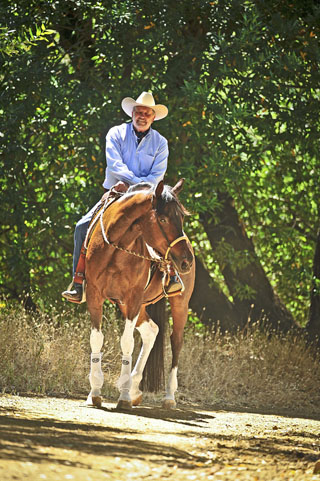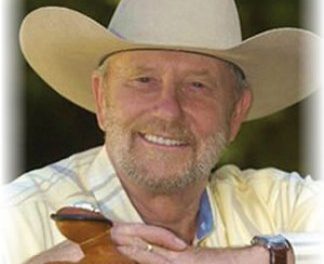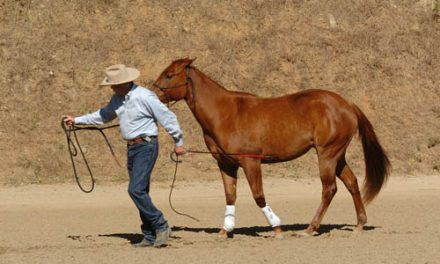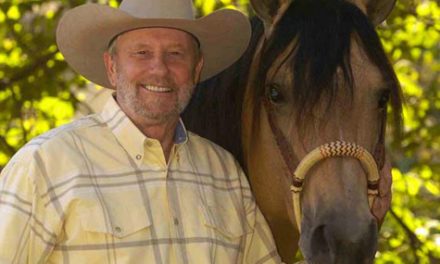This is something that I have heard from people across the country from the west to the east coast. What I hear are two different things but basically they refer to the same problem: My horse bit me/kicked me for the first time. What caused that and what should I do?
My response is always the same and it is never meant in a derogatory or sarcastic way. The horse may have bit/kicked you before, you just didn’t recognize it. What I mean is that any time you approach your horse, you have an opportunity to “read” your horse. This situation happens most frequently in a stall or a stall and paddock. As you approach the stall, the horse’s ears may be back or there may be some aggressive behavior like pawing. This may be because you brought a treat and the horse is anxious and demanding. The horse may be getting a little cranky, telling you to hurry up and feed me. The demeanor of the horse is not pleasant. Sometimes we do not recognize this behavior as a red flag; we pass it off thinking that the horse just wants his treat or feeding.
What this behavior does is become a pattern where the horse starts becoming more aggressive. This behavior may have been going on for years or maybe it only started a month ago. You approach the stall and the ears go back. You don’t think anything about it, but just push your way into the stall and halter your horse. But, the thought is as good as the deed, and one day the horse will actually bite or strike out. When you approach the stall and the horse exhibits a negative attitude, that is how the horse is thinking about you. There is no respect for you and the horse is not greeting you in a friendly way. If you don’t deal with it, the aggression will increase.
I’ve learned this the hard way over many years. I remember one time I went through the same situation and didn’t recognize the signals. I entered a stall and fortunately I had on a leather jacket because as I turned my back to the horse, he bit me on the shoulder and actually threw me across the stall. Since then, I have become more aware of the body language of the horses I work with. With a horse, the thought is as good as the deed.
The other situation that may occur is that as you approach the stall the hind quarters are facing or as you approach the ears are back and the horse turns around and presents the hind quarters. If you fail to do anything and just go ahead and go into the stall, the horse will get more protective of his stall and the aggression will increase until the horses bites or kicks.
Kicking and biting is a very natural way that horses deal with each other in the herd environment. Humans are way too frail to allow this behavior and the way to solve this problem is very simple. I’ve had a lot of good comments from people who walk through my main barn. There are 25 horses and at any given time, even when the feeding cart is coming through and they all know it is feeding time, they are not exhibiting aggressive behavior. They are not lunging against the stall doors, they are not pawing or kicking or showing any impatient behavior.
When I have a horse that exhibits negative behavior when I approach, I have a halter or plastic bucket with me and I pitch it right at the stall. The idea is not to hit the horse or hurt the horse but to startle it. In other words, we want to distract its thoughts because remember, the thought is as good as the deed. So, when you approach and the ears are back or the hind quarters are turned to the door, throw a halter at the door and make enough noise to distract the horse. The horse may jump or go to the other end of the stall but you have distracted the thought. You have to do this on a regular basis; you have to be consistent. So every time you approach the stall and the horse exhibits negative behavior you have to respond in a consistent manner.
The same is true with the a horse who turns his hind quarters as you approach. I take it further than distracting and teach the horses to face me as I go into the stall. I have a hard time putting a halter on a horse’s hind end. I always make sure they turn and face me and present themselves in an orderly fashion. To get the horse to turn and face you, bang the gate and if the horse does not turn, tap on the hind quarters with a lunge stick just until the horse moves his feet and turns.
This is what I call stall manners. Some people think the stall belongs to the horse and he can do anything he likes. I disagree with that. When I walk into a stall, I want good behavior, a positive attitude, I want the horse thinking about me in a respectful way.
Remember, if you get bitten or kicked for the first time, it really wasn’t the first time. It started days, weeks, months or even years ago because the thought is as good as the deed. Also, remember, it is never, ever the horse’s fault.




